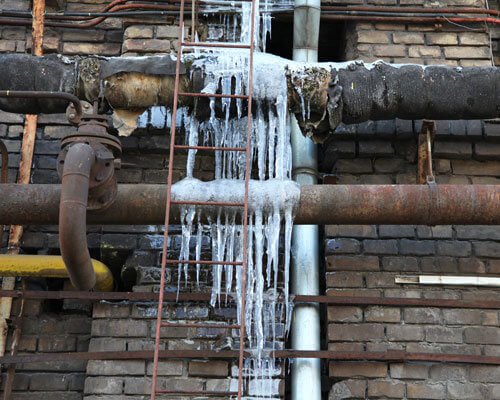Steps to Take If My AC Pipe Is Frozen - Quick Solutions for Unfreezing
Steps to Take If My AC Pipe Is Frozen - Quick Solutions for Unfreezing
Blog Article
Listed here in the next paragraph you will find more superb expertise on the subject of What Causes AC Pipes To Freeze?.

Intro
Finding that your a/c pipeline is iced up can be concerning, specifically throughout hot summer season when you rely upon your air conditioner the most. Comprehending what to do in such a situation is important to avoid additional damage to your cooling system and guarantee your convenience inside your home.
Comprehending the Causes
Several variables can contribute to the freezing of an air conditioner pipeline. Recognizing these causes can aid you attend to the issue successfully.
Absence of Airflow
One common root cause of a frozen AC pipe is inadequate air movement. When the airflow over the evaporator coil is limited, it can trigger the coil to drop below freezing temperature, leading to ice formation on the pipe.
Low Refrigerant Levels
Not enough refrigerant degrees in your a/c system can likewise lead to an icy pipe. Reduced refrigerant degrees can cause the pressure in the system to go down, resulting in the freezing of dampness on the evaporator coil.
Winter Conditions
In cooler climates, freezing temperatures outside can add to the cold of air conditioner pipes. If your a/c system is not effectively shielded or if there are leaks in the ductwork, cool air can infiltrate the system, creating the pipeline to ice up.
Dirty Air Filters
Unclean or stopped up air filters can limit airflow in your air conditioner system, leading to different concerns, including an icy pipeline. It's essential to change or cleanse your air filters on a regular basis to make certain correct air movement and avoid ice buildup.
Indications of a Frozen AC Pipe
Acknowledging the signs of an icy AC pipeline is critical for timely activity.
Reduced Airflow
If you observe a significant reduction in air movement from your vents, it could suggest an icy pipeline.
Ice Buildup on the Pipe
Visible ice buildup on the refrigerant line or the evaporator coil is a clear sign of an icy AC pipe.
Unusual Sounds from the Unit
Uncommon audios, such as hissing or bubbling, coming from your air conditioner unit can signify that there's ice present on the pipeline.
Immediate Actions to Take
When confronted with a frozen AC pipe, it's necessary to act promptly to avoid additional damages to your cooling system.
Switching off the AC
The initial step is to turn off your a/c to avoid the system from running and aggravating the concern.
Checking for Blockages
Evaluate the location around the interior unit for any type of blockages that may be obstructing air flow, such as furniture or curtains.
Defrosting the Pipe
You can utilize mild methods like putting towels taken in warm water around the icy pipe to assist thaw it gradually.
Preventive Measures
Taking preventive measures can aid avoid future incidents of an icy AC pipe.
When DIY Methods Fail
If your attempts to thaw the pipeline or address various other issues are unsuccessful, it's time to employ a specialist.
Importance of Hiring a Professional HVAC Technician
A licensed HVAC professional has the knowledge and tools needed to identify and repair problems with your air conditioning system safely and successfully.
Routine Maintenance Checks
Schedule regular upkeep checks with a specialist HVAC service technician to ensure that your a/c system is running efficiently.
Altering Air Filters
Regularly change or cleanse your air filters to prevent airflow restrictions and preserve optimal performance.
Insulating Exposed Pipes
If your a/c pipelines are subjected to chilly temperatures, take into consideration shielding them to prevent cold throughout winter months.
Seeking Professional Help
If DIY approaches stop working to fix the issue or if you're not sure about exactly how to continue, it's best to seek support from a qualified HVAC professional.
Final thought
Taking care of a frozen air conditioning pipe can be an irritating experience, however recognizing just how to react can aid decrease damages and bring back comfort to your home. By comprehending the causes, recognizing the signs, and taking punctual activity, you can successfully attend to the problem and prevent future events.
G UP? HOW TO FIX IT?
It happens all over America. And the rest of the world probably. It’s the hottest day ever and for some darn reason your AC isn’t cooling the house. You fiddle with the thermostat to try and fix the problem. Nada. All you can do now is go outside and check the AC unit. You make your way there and find your air conditioner unit is frozen! But how?
In this post we’ll cover how you can tell that your air conditioner has frozen (other than the obvious reasons), what could have caused the freeze, and some of the things you can do about your AC freezing up. And if you have a frozen heat pump condenser, read our blog about it to learn what to do! But remember, it is always best to avoid your AC freezing up with an AC tune up. And if you are moving into a home, it's critical to get HVAC inspection so that you are aware of an AC problems before you move in.
Keep reading and you may be able to fix the frozen AC yourself. If you can’t, call an HVAC specialist. If you live in Maryland, call SuperTech HVAC for AC repair. We’ll take care of it.
How Does An Air Conditioning Unit Work?
How you probably imagine an AC works is wrong. Contrary to popular belief, an AC system does not inject cool air into a building. Instead, it removes the heat from inside and transfers it outside. Cool huh? (Pun intended).There are 4 major components among the 3 stations of an air conditioning system: the evaporator coil, the compressor, the condenser, and the refrigerant – a special chemical that links everything together through a closed loop system.
Station 1:
Warm indoor air is sucked into the return vent, through a filter, and blows over the evaporator coil. The heat is absorbed into the cold refrigerant, turning it from liquid to gas. The air, which is now cool, is blown back into the home to areas that your thermostat, i.e. you, has decided.
Station 2:
The refrigerant makes its way outside the house to the compressor, which squeezes the warm refrigerant, raising its gaseous temperature even more.
Station 3:
When the super hot vapor refrigerant reaches the condenser, the last step, the heat is expelled and absorbed into the outdoor air. The refrigerant instantly cools, which changes it from gas back to liquid form. The cold liquid refrigerant is now ready to return to station 1 and repeat the process.
Is Your AC Freezing Up? Here Are The Signs:
As you may have guessed, your air conditioner unit freezing up on a hot day is not normal.
If this happens, there's no need to panic. Often the issue can be solved with a little troubleshooting. If the AC unit is left frozen for too long however, you may find yourself with a bigger problem.
First things first, how do you know your AC is frozen?
Well, the obvious sign is the ice on your refrigerant line-set pipe. Simply check between your outdoor AC unit and your home's exterior wall to see whether your AC line frozen.
You might also have a frozen evaporator coil. This one's not as easy to check. You'll need to open a panel on the indoor unit to inspect. Don't do this unless you're handy. If you aren't, call an HVAC pro like SuperTech HVAC or you may damage something in the process.

Do you appreciate reading about How can I fix an air conditioner’s frozen pipe?? Give a review down below. We would be delighted to see your opinion about this content. We hope to see you back again later on. Sharing is nice. Helping others is fun. Thanks a bunch for your time. Please come visit our site back soon.
Set An Appointment Report this page